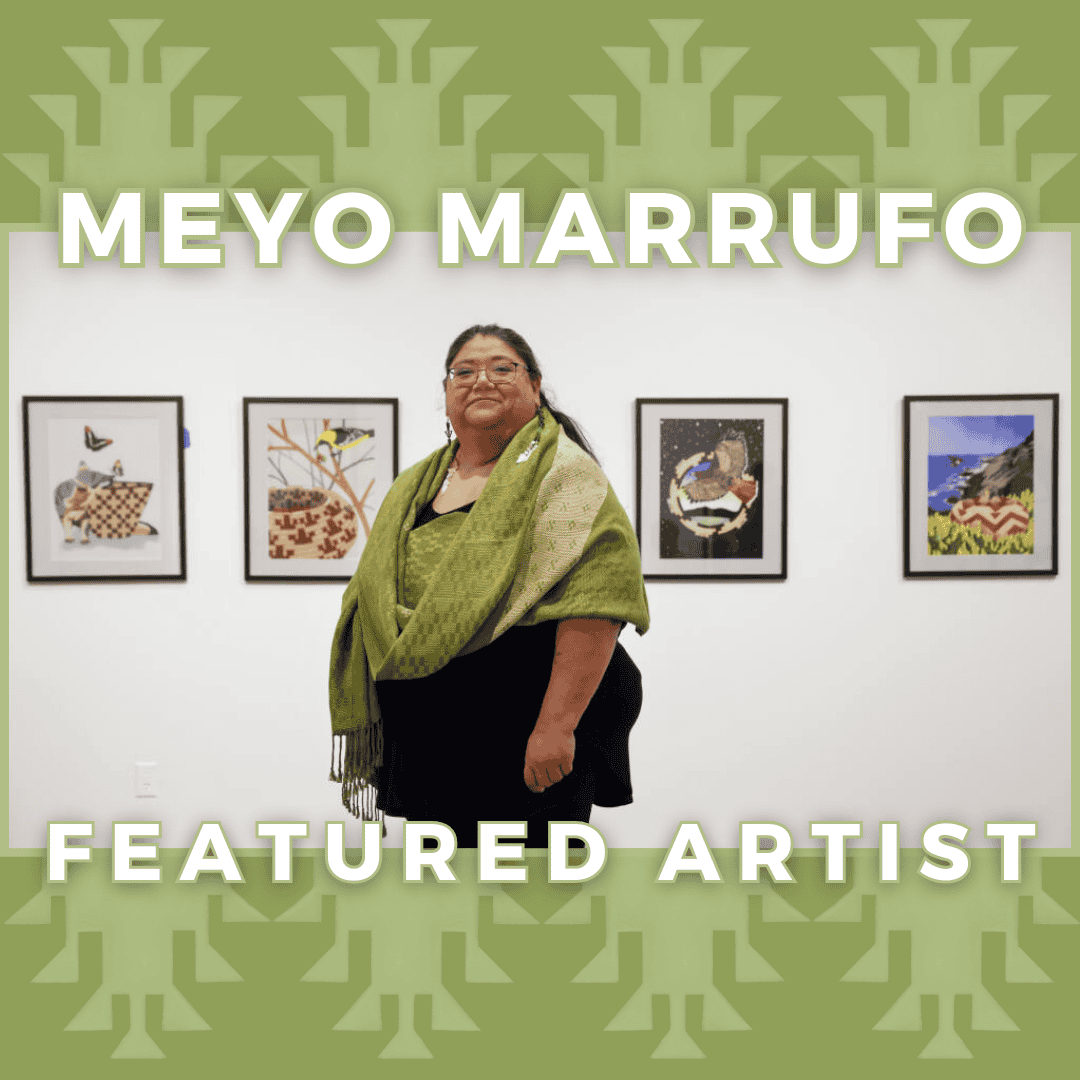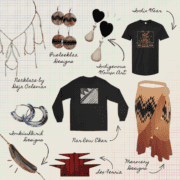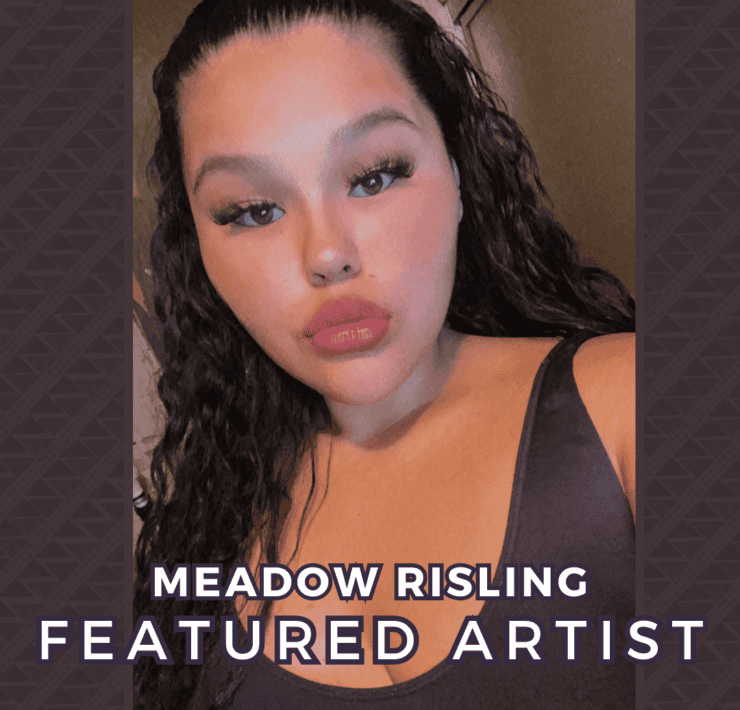
by Tavi Lorelle Carpenter
I am very excited to be able to share the final featured artist for this series, and I am sure many of you will be familiar with her. Meyo Marrufo (Eastern Pomo from the Clear Lake Basin and citizen of Robinson Rancheria) has long contributed to News from Native California and is the current environmental director at the Guidiville Rancheria in Ukiah. However, she is also a basket weaver, beader, visual artist, and art curator for exhibits featuring California Indigenous artists. I was fortunate enough to have the opportunity to speak with Meyo about artistry and creativity.
Meyo’s journey into art can be credited with an early introduction to artists.
“I’ve always been surrounded by artists. I had my first painting class by Frank Tuttle. My dad is a writer and an artist; my mother was an artist in her own right. My aunties are artists. I’ve always been surrounded by artists and have always enjoyed creating art. [With] my basketry, mom would say, ‘The Pomo hands know!'”
When it came to her beadwork, this was a more recent pursuit. Meyo shared that it was her cousin who had taught her how to freestyle bead.
“With my beadwork, I learned how to do my pendant[s], actually not that long ago. I’ve only been doing those pendants for about maybe 10 years, 15 years at the most. My cousin Maryanne actually taught me how to do freestyle beading because I wanted to make my mom a feather ribbon for breast cancer. And she was like, ‘Oh, let me show you how!’ and from there, it just started. I already knew how to bead but doing freehand and not doing rosettes and not doing, you know perfectly straight lines, being able to incorporate what I wanted-it was fun for me. My mom actually started making pendants with baskets and just having some fun with it. I started doing smaller beads and started incorporating our basket designs [and] also the birds.”
Meyo is also an incredible digital artist. Her pieces, which she calls finger doodles, are beautiful digital drawings that she started creating in a meeting in 2014.
“Normally, I document the environmental meetings that I go into by taking a picture from my phone and then doing a Facebook post on what happened during the meeting. So this particular meeting was a pollinator protection plan, and I was like, you know what? I’m so sick of taking pictures. Let me just draw a bee!”
In the notes app on her phone, Meyo drew a quick little bee and added it to her Facebook post about the meeting. Immediately, she started receiving positive feedback and comments, asking for more! Through this, she started looking at what digital drawing would really need. On an application like the Notes app, one is greatly limited. She ended up downloading a free drawing app called “Sketch” and started exploring what was possible. The term finger doodles aptly describes her work as she is quite literally using her finger!
But it is also very intentional.
“It was purposeful to call them finger doodles. I wanted to keep them fun. I wanted to keep them lighthearted.”
She didn’t want them to become more than what they were, a means of keeping humble, if you will or as Meyo put it: “Finger doodles keeps you grounded.”
Something that came across strongly about Meyo’s finger doodles is how deeply woven they are to the human, plant, animal, and spirit communities in California.
“The majority of my animals, almost all my animals, insects, [and] birds, they’re all California. The majority of my stuff is central California, [the] birds and wildflowers. The Southern California one is because I’m down here in Southern California, so I was doing the superbloom and I did a little cottontail down here. Almost all the basket have been Pomo, they’re all some version of Pomo, unless I’m asked specifically for something else. I think you have to have a connection to your landscape. If you’re going to draw a basket, there’s no need to know how to weave one, but you understand what [it] is that you’re drawing. If you’re going to draw a bird, you don’t have to draw [it] perfectly anatomically correct. But you should understand what it’s connection is to the other portions of your drawing.”
Meyo’s drawings certainly have personality and always tell a story. She told me of one piece that received significant feedback because so many people recognized themselves in the piece!
“I was thinking about Glayds Mankins’ place over in Maidu Country and thinking of the bear dance over there. And I did a little series of just shots of the bear dance when it used to be at Glayds Mankins in Susanville before it moved to Jamestown. And I drew this little girl running from this goose. Glayds Mankins had this goose that hated little girls and the goose would chase us! And so I started getting calls from different Indian women that I know [that saw that drawing] and they were like ‘Oh my God, [why’d] you draw that goose chasing me?’ {and I said] I didn’t draw the goose chasing you, you guys didn’t wear overalls-I did!’ and they were like ‘Oh God, I hated that Goose!’ So this just brought back all these memories!”
In more challenging periods, such as the pandemic, Meyo started leaning more into her art as a way of connecting with the community.
“I found out during harder times, like when Covid happened-I started drawing a lot of brighter pictures. I had a lot of brighter flowers, brighter baskets, brighter imagery. Because I was sharing it with people, every once in a while I would print out cards and just send them out to my list. I think I had like 50 people on my list. I sent out this card [where] I just said: Stay strong. Stay Safe. I love you, Meyo. And I got people that called me up and said, ‘You just don’t know how much I needed that card today’. And so my list became bigger.”
Alongside cards, she had also sent out a poster encouraging people to wash their hands, an important reminder to help prevent the spread of illness, particularly during pandemic times. Meyo continued to do these acts of kindness and sometimes received financial donations to help with shipping costs. She always received highly positive feedback, and indeed, I myself can’t help but agree with how generous, kind, and sweet it is to be given that kind of gift, particularly during a time of great hardship such as the pandemic.
“Everybody’s like, oh you’re so wonderful, that was so nice that you did that. And I was like, no, it wasn’t. No, that wasn’t nice, I said. That was me not wanting to lose anybody else. I said, actually, when you think about it, it’s very selfish!”
Meyo, who is undoubtedly multifaceted, incredibly talented, and extremely wise, is also self-aware, humble, and community-oriented.
Another hat Meyo wears is that of Art Curator, and she’s done quite a few shows, with her most recent group exhibit, “Wa Hinthil Come North”, presented at Cal Poly Humboldt’s Goudi’ni Native American Arts Gallery. Meyo had participated in many art shows throughout the years, but it wasn’t until about six years ago that she entered the world of curation.
“Sigrid Benson from Shingle Springs Rancheria asked if I would like to be in the show, and I asked her, ‘So how do you put these together?’ She [asked me], ‘Do you want to learn?’ So, I got to watch her do some curating. Then, I worked with Eric Wilder and Ron Lockhart, and we curated a show called “We Are Still Here” [at the Mendocino Art Center], and I actually was able to implement some of the curation practices that I had been learning.”
Meyo told me that she had originally gone to school for museum studies.
“I ended up in environmentalism for 25 years! But my original schooling was [in] museum studies. Curation is something I [have] always wanted to do. That’s what I was studying for. My mom worked for American Indian Contemporary Arts in San Francisco with Janeen Antoine. So I got to watch some of the things they did.”
Meyo’s exhibits offer spaces for Indigenous artists’ work to be seen by a broader audience. I asked Meyo if she could share the importance of spotlighting Native artists and some of the challenges that she’s encountered.
“There’s definitely challenges.” Meyo told me. “First of all, Native artists need to be recognized because they are the first people of this nation. Their art [is representing where] the Earth is going right now-to me! There’s a connection in the land that oftentimes is missed by non-Natives. The other part of some of the more complicated because their aren’t a lot Native shows because we are not considered, you know, right now we’re a fad, right now, it’s really cool to be Indian right now, this is a cool time. Biden has put money in the arts for Native Americans, you know there’s federal policies that are incorporating traditional ecological knowledge now, so right now we’re in the heyday. So getting venues right now is easier in some cases but it’s harder because we’re in trend they want to see quote-on-quote Indians. They don’t see us as contemporary artists, they see us as Indian artists. And there’s people trying to break that barrier. This whole brand new generation of contemporary artists. We have legacy artists that help break that barrier, [such as] Harry Fonseca, Frank LaPeña, Dugan Aguilar, Kathleen Smith. We have those contemporary artists like Frank Tuttle and Judith Lowry that are international artists that are taking their styles abroad as Native American artists, but also as fully contemporary artists recognized.”
Meyo is also conscious of the importance of getting into specifics. For herself, it’s important that she is recognized not just as an Indian artist but as a California Indian artist.
“[Using the term Indian Artists] in itself is complicated because it is not recognizing the sovereignty of our individual nations. When people look at me, I tell them I’m a California Indian artist, I’m a pomo artist. I am not Plains. I am not Southwest. I am not Easter Woodlands, I am Californian. And there’s very specific things about California Indian artists.”
I asked Meyo, as I had of many other artists that were part of this series, what advice she had for young Native artists that were just getting started.
Meyo shared a story of how impactful word art can be, as she found out while curating a show where there would be something to honor those who had passed on due to Covid. Meyo wanted to be sure that it would be respectfully representative of the profound loss Covid had on those who passed and those who had experienced loss.
“Covid, nationally, hit us really hard, but tribally, Covid hit us immensely. We lost so many elders and so many younger people during Covid. . . I talked to a word artist, Laura Inong, and I asked her if I could use one of her poems that she wrote for her dad. . . She created these beautiful poems that spoke to all of our griefs. I asked her if I could quote one of these poems in my art show. . .and I [told her] your poems speak to what we are going through and you articulated it so wonderfully.”
Meyo made a big printout to put in the art exhibit of Ms. Inong’s poem, “All the Magic,” and she shared with me that one of the workers in the museum had asked if she could have the poem. The museum worker shared that her husband had passed from Covid and that the piece touched her heart. After speaking with Laura, Meyo did just that.
She ended this story by sharing with me:
“That’s the impact of word art. And you know, we forget how important it is to articulate who we are and what we are. Especially as oral history people.”
When it comes to supporting Meyo, she put it like this: “You can support me by supporting other artists. We’re not going to create artists and we’re not going to sustain our artists if we don’t support our artists.”
Wise words!
Thank you so much, Meyo!







